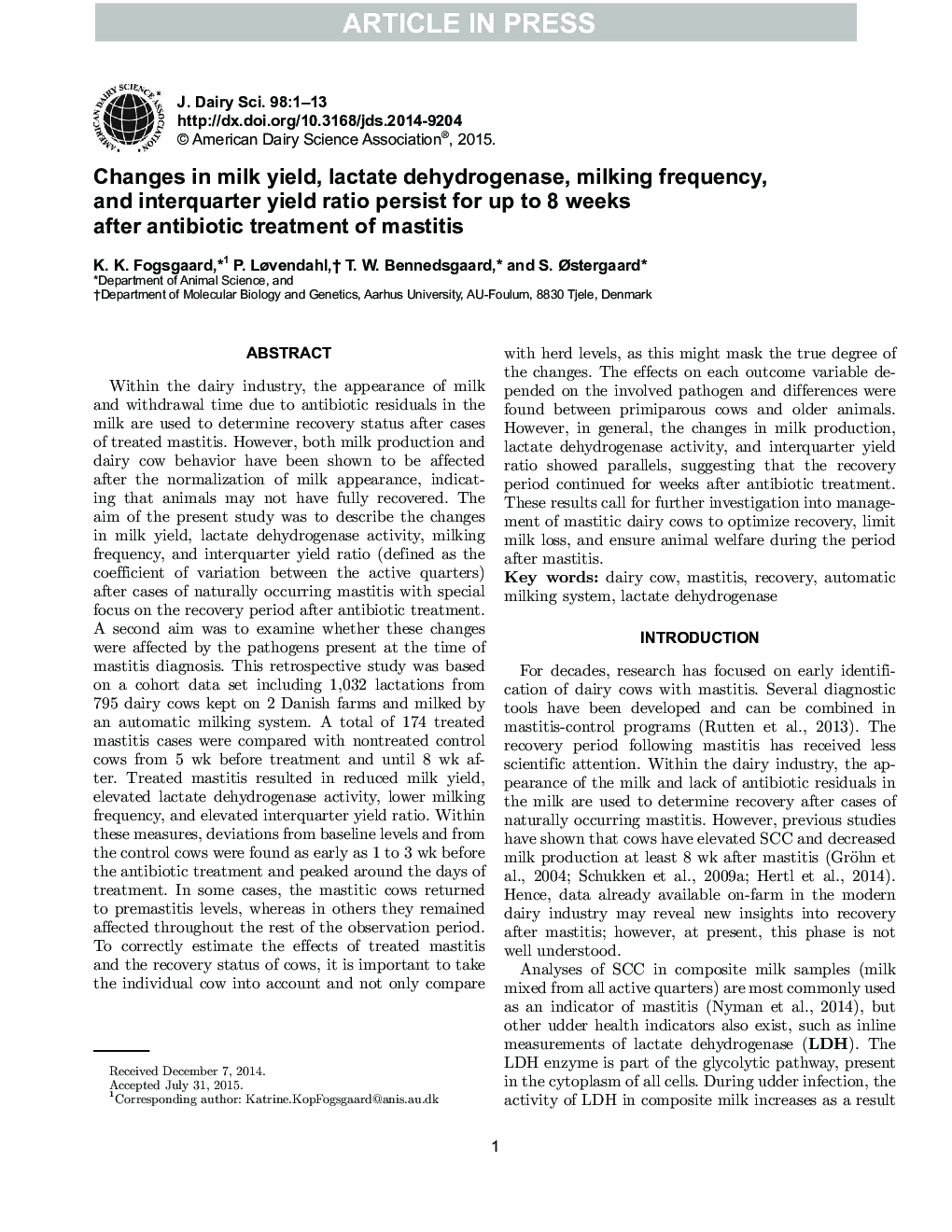| کد مقاله | کد نشریه | سال انتشار | مقاله انگلیسی | نسخه تمام متن |
|---|---|---|---|---|
| 10974527 | 1108026 | 2015 | 13 صفحه PDF | دانلود رایگان |
عنوان انگلیسی مقاله ISI
Changes in milk yield, lactate dehydrogenase, milking frequency, and interquarter yield ratio persist for up to 8 weeks after antibiotic treatment of mastitis
ترجمه فارسی عنوان
تغییرات در عملکرد شیر، لاکتات دهیدروژناز، فرکانس شیردوشی و نسبت عملکرد ماهیانه تا 8 هفته پس از درمان آنتی بیوتیک ماستیت
دانلود مقاله + سفارش ترجمه
دانلود مقاله ISI انگلیسی
رایگان برای ایرانیان
کلمات کلیدی
گاو شیری، ماستیت، بهبود، سیستم دوش اتوماتیک اتوماتیک، لاکتات دهیدروژناز،
موضوعات مرتبط
علوم زیستی و بیوفناوری
علوم کشاورزی و بیولوژیک
علوم دامی و جانورشناسی
چکیده انگلیسی
Within the dairy industry, the appearance of milk and withdrawal time due to antibiotic residuals in the milk are used to determine recovery status after cases of treated mastitis. However, both milk production and dairy cow behavior have been shown to be affected after the normalization of milk appearance, indicating that animals may not have fully recovered. The aim of the present study was to describe the changes in milk yield, lactate dehydrogenase activity, milking frequency, and interquarter yield ratio (defined as the coefficient of variation between the active quarters) after cases of naturally occurring mastitis with special focus on the recovery period after antibiotic treatment. A second aim was to examine whether these changes were affected by the pathogens present at the time of mastitis diagnosis. This retrospective study was based on a cohort data set including 1,032 lactations from 795 dairy cows kept on 2 Danish farms and milked by an automatic milking system. A total of 174 treated mastitis cases were compared with nontreated control cows from 5Â wk before treatment and until 8Â wk after. Treated mastitis resulted in reduced milk yield, elevated lactate dehydrogenase activity, lower milking frequency, and elevated interquarter yield ratio. Within these measures, deviations from baseline levels and from the control cows were found as early as 1 to 3Â wk before the antibiotic treatment and peaked around the days of treatment. In some cases, the mastitic cows returned to premastitis levels, whereas in others they remained affected throughout the rest of the observation period. To correctly estimate the effects of treated mastitis and the recovery status of cows, it is important to take the individual cow into account and not only compare with herd levels, as this might mask the true degree of the changes. The effects on each outcome variable depended on the involved pathogen and differences were found between primiparous cows and older animals. However, in general, the changes in milk production, lactate dehydrogenase activity, and interquarter yield ratio showed parallels, suggesting that the recovery period continued for weeks after antibiotic treatment. These results call for further investigation into management of mastitic dairy cows to optimize recovery, limit milk loss, and ensure animal welfare during the period after mastitis.
ناشر
Database: Elsevier - ScienceDirect (ساینس دایرکت)
Journal: Journal of Dairy Science - Volume 98, Issue 11, November 2015, Pages 7686-7698
Journal: Journal of Dairy Science - Volume 98, Issue 11, November 2015, Pages 7686-7698
نویسندگان
K.K. Fogsgaard, P. Løvendahl, T.W. Bennedsgaard, S. Ãstergaard,
